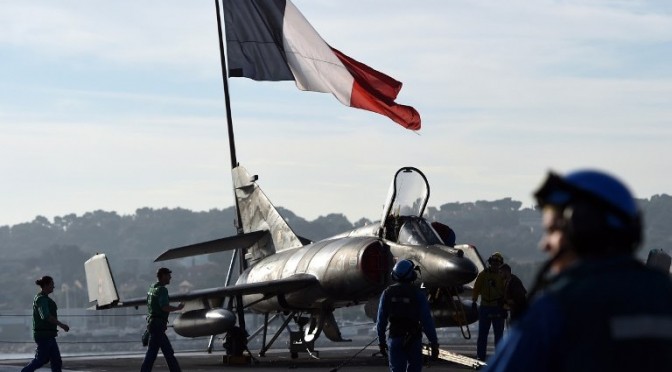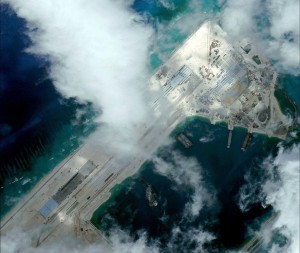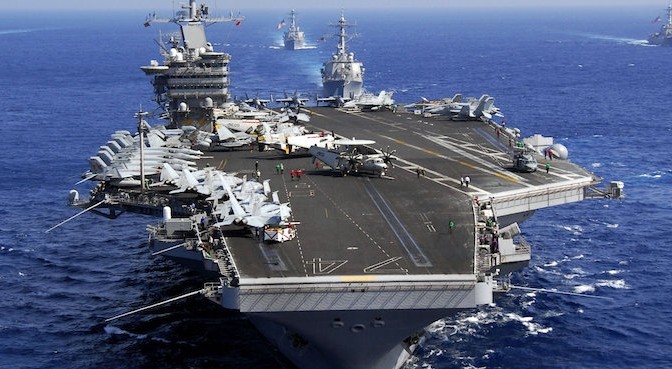Welcome to the November 2015 Member Round-Up. Over the past several weeks CIMSEC members have examined several international maritime security issues, including the modernization of U.S. Naval capabilities and strategies, France’s air war against ISIS, Russian military involvement in the Syrian conflict, the future of the U.S. Air-Sea Battle operational concept and growing maritime trilateral relations between India, Japan and the U.S.
[otw_shortcode_button href=”https://cimsec.org/buying-cimsec-war-bonds/18115″ size=”medium” icon_position=”right” shape=”round” color_class=”otw-blue”]Donate to CIMSEC![/otw_shortcode_button]
Beginning the Round-Up at The Center for Strategic and Budgetary Assessments, Bryan Clark discusses the unsustainable operational stress the U.S. Navy and Marine Corps are facing with longer and more frequent deployments in multiple areas of operation. As the U.S. combats ISIS across Africa and the Middle East while also addressing Chinese and Russian international boundary conflicts, Mr. Clark explains that current processes to prepare forces for deployment are insufficient and limit the abilities for naval and marine forces to deliver certain capabilities effectively. Also at CSBA, Mr. Clark explains the affects of a decreasing Defense Department budget and the possible steps it can take to minimize the impact of reduced spending levels.
Chuck Hill, for his Coast Guard Blog, discusses the development of the National Fleet Plan and its objective to increase cooperation between the U.S. Navy and Coast Guard through increased opportunities of commonality and interoperability. Mr. Hill describes the strategic laydown of the plan concerning shared facilities and ports, particularly the stationing of Coast Guard Offshore Patrol Cutters at U.S. Naval bases.
At The War on the Rocks, Bryan McGrath provides an analysis outlining key components of Republican presidential candidate Marco Rubio’s military modernization platform. Mr. McGrath is supportive of Rubio’s focus to place priority on undersea and electronic warfare technologies considering these features of naval power are imperative for the U.S to maintain primacy in the maritime domain. Further to this, the strategy supports the development and construction of the Navy’s next ballistic missile submarine (SSBN(x)), the Air Force’s LRS-B and modernization of the U.S. nuclear arsenal to enhance strategic deterrence in the future.
Also on the future of U.S. military and naval strategy, Harry Kazianis at The National Interest shares an interview he recently participated in with the Air-Sea Battle Office. In the interview Mr. Kazianis poses several questions concerning the operational capabilities of U.S. forces within challenging environments where advanced Anti-Area/Access-Denial strategies are in effect. The interview focuses on the applicability and difficulties key components of the ASB concept encounter within A2/AD environments and the corresponding development of the Joint Concept for Access and Maneuver in the Global Commons (JAM-GC) framework.
Entering the Asia-Pacific, Mira Rapp-Hooper at Lawfare discusses the U.S.S. Lassen’s freedom of navigation operation (FONOP) in the Spratly Islands and the legal implications the operation has concerning the status of the U.S. government’s recognition of the artificially constructed islands. Ms. Rapp-Hooper analyzes the U.S.S. Lassen FONOP attempting to establish whether the operation was an exercise of innocent passage or a demonstration of normal military operations within the surrounding Chinese-claimed 12 n.m. territorial waters. Ankit Panda, at The Diplomat, also interprets tensions in the South China Sea with an explanation of the political statements released from senior Chinese and American officials. Mr. Panda discusses the opposing remarks provided by Chinese President Xi Jinping and U.S. Defense Secretary Ashton Carter concerning U.S. FONOP’s in the South China Sea and the overall security of the region’s maritime domain.
Paul Pryce, for Offiziere, explains aspects of the Papua New Guinea Defense Force procurement strategy and the regional pressures demanding its success. Mr. Pryce suggests that Papua New Guinea become a more independent actor in terms of patrolling and monitoring its territorial waters without extensive foreign assistance from regional allies such as Australia. The procurement of affordable high-capacity offshore patrol vessels as opposed to advanced and expensive frigates is crucial for New Guinea to develop the ability to control its expansive EEZ territory and contribute to maritime stability within the region.
To conclude the November Round-Up, Darshana M. Baruah also for Offiziere, discusses the evolving trilateral relationship between Japan, India and the U.S. in the Indo-Pacific. An analysis of the trilateral naval exercise Malabar 2015, where an aircraft carrier, missile cruisers and frigates participated, reveals that the alignment of Indian, American and Japanese interests are consistent with the developing geo-strategic landscape of the region. Ms. Baruah suggests that the rise of China and the changing dynamics of maritime security and naval strategy have resulted in the need for these new political and strategic arrangements.
Members at CIMSEC were also active elsewhere during the month of November:
- Robert Farley, at The National Interest, provides an analysis of five likely regional conflicts capable of escalating into an international conflict resulting in the start of World War III. In a second article at The National Interest, Mr. Farley explains how the U.S. anti-submarine capabilities developed during the cold war diminish the current credibility of the Chinese maritime nuclear deterrent.
- Sam LaGrone, at S. Naval Institute News, shares two articles regarding the establishment of a Chinese military base near the Gulf of Aden as well as the French air campaign against ISIS targets in Iraq and Syria. The first article discusses the confirmation from U.S. Africa Command concerning the official formation of a Chinese forward operating base in Djibouti. The second article outlines the ongoing operations of a French carrier battle group stationed in the Mediterranean.
- Dave Majumdar, at The National Interest, explains the strategic and political consequences of Russia’s S-400 surface-to-air missile defense system being deployed to Syria in response to Turkey shooting down a Russian Sukhoi Su-24 bomber. In a second article, Mr. Majumdar describes the pair of Turkish F-16C fighters engaging the Su-24 bomber and analyzes the international response to the event.
- James Stavridis on Bloomberg Business explains the significance of the Turkish Presidential elections and the outcome it can have regarding alterations in the region’s balance of power. Additionally, ADM. Stavridis discusses the dynamics of the Syrian conflict and the requirement of both diplomatic efforts towards the Assad regime and united NATO military operations towards ISIS to stabilize the region.
- At The National interest, Ankit Panda describes major organizational changes within China’s Peoples Liberation Army. This restructuring intends to consolidate power throughout the hierarchal governance system within the army. Within the article, Mr. Panda also discusses institutional shortcomings concerning Iran’s ICBM development programs.
At CIMSEC we encourage members to continue writing, either here on the NextWar site or through other means. You can assist us by emailing your works to dmp@cimsec.org.
Sam Cohen is currently studying Honors Specialization Political Science at Western University in Canada. His interests are in the fields of strategic studies and defense policy and management.
[otw_shortcode_button href=”https://cimsec.org/buying-cimsec-war-bonds/18115″ size=”medium” icon_position=”right” shape=”round” color_class=”otw-blue”]Donate to CIMSEC![/otw_shortcode_button]





